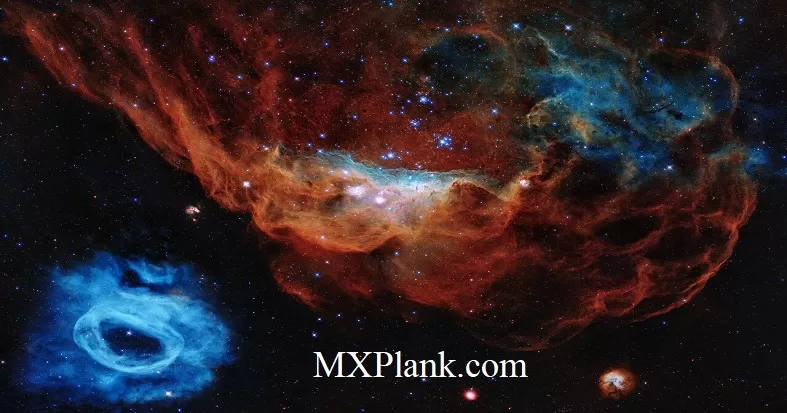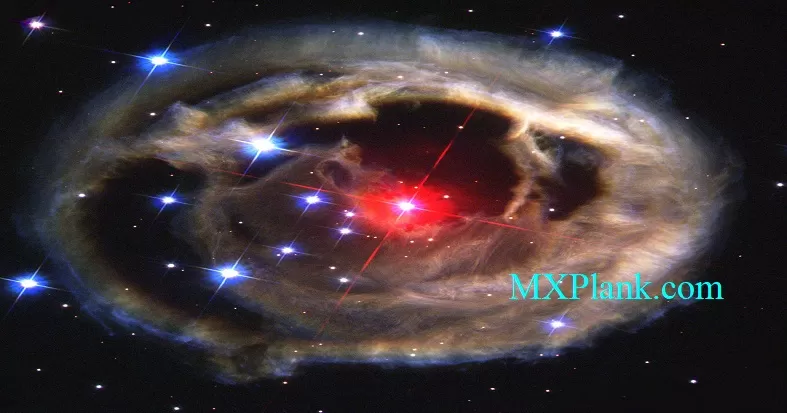Identification of extrasolar planet host star

[bottom left text]
Hubble Space telescope observed and identified the host star to a gravitationally lensed planet first discovered in 2003 by ground-based telescopes.
[left box]
A foreground red star and planet drifts toward the sky position of a much farther sunlike background star.
[middle-boxes]
In 2003, the foreground star-planet system slightly amplifies the light of a background star that momentarily aligns with it. This is called a microlensing event.
[right box]
The light from each star is progressively more offset year after year as the foreground star drifts by.
[bottom right box]
In 2005, Hubble Space Telescope observations distinguished the light from the two stars. This was possible because the foreground star turns out to be a different colour from the background star. By observing the stars though a red and blue filter, astronomers were able to enhance the visibility of the offset. The relative offset is 0.7 milliarcseconds (the angular width of a dime seen 3,000 miles away) from the source star. (This is below Hubble's resolution, but still a measurable effect.) The deduced positions of the two stars in 2005 are shown with red and blue crosshatches.
This post presents the results of HST observations of the host star for the first definitive extrasolar planet detected by microlensing.
The light curve model for this event predicts that the lens star should be separated from the source star by ~6mas at the time of the HST images.
If the lens star is a late G, K or early M dwarf, then it will be visible in the HST images as an additional source of light that is blended with the source image.
Unless the lens and source have exactly the same colors, its presence will also be revealed by a systematic shift between centroids of the source plus lens in different filter bands.
The HST data indicates both of these effects: the HST source that matches the position of the source star is 0.21 magnitudes brighter in the ACS/HRC-F814W filter than the microlensing model predicts, and there is an offset of ~0.7mas between the centroid of this source in the F814W and F435W filter bands.
We conclude the planetary host star has been detected in these HST images, and this identification of the lens star enables a complete solution of the lens system.
The lens parameters are determined with a Bayesian analysis, averaging over uncertainties in the measured parameters, interstellar extinction, and allowing for the possibility of a binary companion to the source star.
This yields a stellar mass of M_* = 0.63(+0.07/-0.09) M_solar and a planet mass of M_p = 2.6 (+0.8/-0.6) M_Jup at an orbital separation of 4.3 (+2.5/-0.8) AU.
Thus, the lens system resembles our own Solar System, with a planet of ~3 Jupiter-masses in a Jupiter-like orbit around a star of two-thirds of a Solar mass.
These conclusions can be tested with future HST images, which should reveal a broadening of the blended source-plus-lens point spread function due to the relative lens-source proper motion.
Gravitational Microlensing can be thought of as a version of strong gravitational lensing in which the image separation is too small to be resolved.
Multiple images are formed, but their typical separation - ∆Θ ≉ 2 ΘE - is far below the limiting resolution determined by observational constraints.
Given the dependence of the Einstein radius on lens mass and geometry, it is clear that microlensing will occur for sufficiently small masses and sufficiently distant lenses and sources.
In very general terms, microlensing deals with the lensing effects of compact objects in the mass range 10-6 = m/M⊙ ≤ 106.
This translates into Einstein radii/angular separations of a milli-arcsecond or smaller for the two main distance regimes: "galactic" - lens/source distances of order 10 kpc, and "extragalactic/cosmological" - lens/source distances of order Gpc.
NASA/ESA and The Hubble Heritage Team (STScI/AURA)






